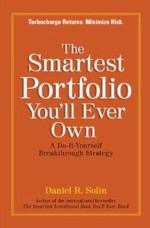

 There comes a time in every Couch Potato’s life when he or she has to answer a nagging question: can I do better? Sure, the three or four plain-vanilla funds in the Global Couch Potato have an excellent track record. But they’re just so dull. Surely you can squeeze out even better performance with a more sophisticated portfolio.
There comes a time in every Couch Potato’s life when he or she has to answer a nagging question: can I do better? Sure, the three or four plain-vanilla funds in the Global Couch Potato have an excellent track record. But they’re just so dull. Surely you can squeeze out even better performance with a more sophisticated portfolio.
Financial advisor and author Dan Solin hears the question all the time. His previous book, The Smartest Investment Book You’ll Ever Read (Viking, 2006) is one of my recommended reads for new or would-be passive investors. That book, he writes, “spawned tens of thousands of savvy investors. They wanted to know if there was any way to improve the returns of the index fund portfolios I recommended.”
The answer is the basis of Solin’s newest book, The Smartest Portfolio You’ll Ever Own (Perigee/Penguin, 2011). It takes things one step further—actually, it takes things two factors further. The book explains how index investors can use the Fama-French Three-Factor Model to tilt their portfolios to value and small-cap stocks.
A new dimension in ETFs
Solin is an adviser who uses Dimensional Funds, which are built on the Fama-French principles. As he explains, value stocks and small-cap stocks have historically delivered higher returns than the overall market, albeit with correspondingly higher volatility.
Dimensional Funds are available only from a select group of advisors, so Solin’s “SuperSmart Portfolio” is designed for do-it-yourselfers who want to use a similar strategy. His model portfolio is made up of both ETFs and Vanguard mutual funds—but since the latter are not available to Canadians, I’ll substitute the equivalent ETFs. This is his suggestion for an investor with a moderate risk tolerance:
.
Solin devotes a lot of space to the historical returns of his SuperSmart Portfolio. Backtestsing always needs to be viewed with some skepticism, but his assumptions here are reasonable. He uses actual fund returns wherever possible (some Vanguard funds go back to the 1990s), and otherwise he uses data from the indexes they track, minus the fund’s current fee. Given that Vanguard and iShares have excellent records of keeping tracking errors low, this is not an unfair comparison. Readers may be surprised to learn that the above portfolio’s annualized return for the 10 years ending in 2010 was 6.54% (in US dollars). So much for the lost decade.
The SuperSmart Canadian
Faithful readers will be aware that I too have designed an ETF portfolio to capture the small and value premiums: the Über-Tuber. It’s the most complex of my model portfolios, but it may be suitable for investors with at least $100,000—preferably more. (Incidentally, Solin suggests the same minimum account size for his SuperSmart Portfolio.) An advisor who uses Dimensional funds recently ran some backtests on the Über-Tuber and found that it would have done a good job of capturing the small and value premiums for Canadian investors over the last 15 years. (Again, the usual caution about backtesting applies.)
One of the main differences between Solin’s portfolio and my own is that he suggests putting half of your fixed income in international bonds, without currency hedging. Many portfolio managers advise against taking currency risk on the bond side: in fact, Solin’s suggestion goes against the opinion of Dimensional Fund Advisers, who recommend using currency hedging as part of their fixed income strategies.
The final section of the book deals with the question of whether index invetsors need an advisor. I’ll discuss Solin’s ideas on this topic in my next post.












